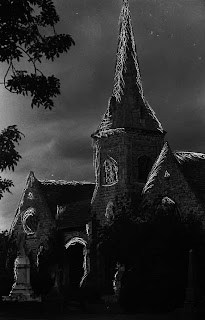In my independent time I experimented with working on top of prints that I had made in the darkroom. I used a pin to scratch away parts of the image. I was not quite sure what I was going to scratch away, I started with the spire on the church but after thinking more carefully I thought of scratching certain parts so that it looks like the moonlight is reflecting off of the church.
This was the second experiment I tried with scratching into the photograph. I chose a print that didn't come out well as I was only interested in the detail of the patterns scratched into it. I used a pin to scratch flowers and leaves into the photograph.
I wanted to take this experiment further so I drew flowers onto a piece of plastic and placed it over the photographic paper whilst exposing the photograph. For the second photograph I drew ducks onto a sheet of plastic so it looked like they were in the water. The third experiment I used tracing paper and drew buildings on it.

















































